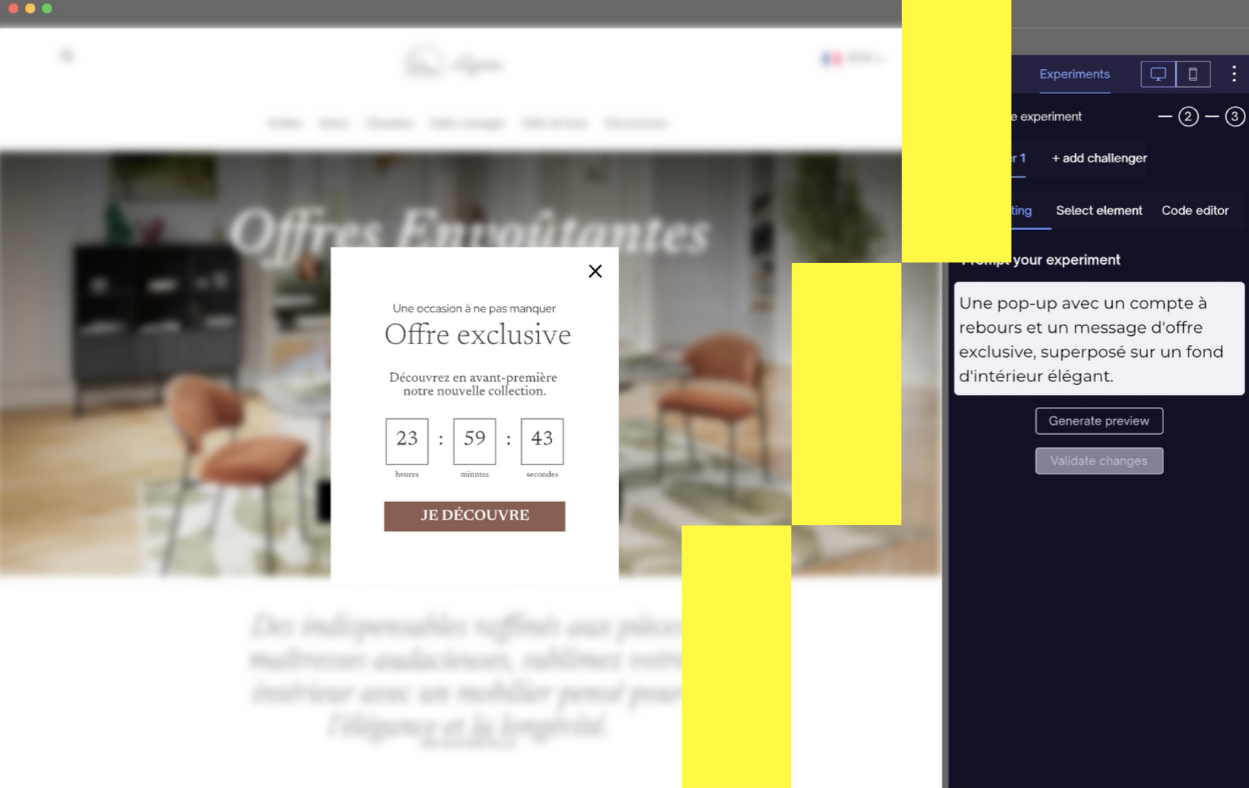
De nos jours, c’est très simple de créer un site internet.
Il existe une multitude d’outils, CMS et autres technologies qui permettent de construire un site internet en quelques heures. Les chiffres du gouvernement en témoignent : il y a plus de +10 000 sites e-commerces en France chaque année.

Cependant, il est extrêmement compliqué de vendre en ligne. Historiquement, la croissance des business en ligne dépendait exclusivement des campagnes d’acquisition de trafic payantes. Les sites payaient des publicités pour faire venir des visiteurs sur leur site en espérant que ceux-là achètent. Et cela malgré les faibles taux de conversions, aux alentours de 2%. Mais les coûts d’acquisition ont triplé au cours des cinq dernières années, ce qui laisse peu de retours sur investissement dans la simple augmentation des budgets d’acquisition. Dans un monde où le commerce en ligne est en constant recul depuis l’ère post-covid, cela menace la pérennité de beaucoup de sociétés. La nouvelle clé est la conversion.
Pourtant, l’optimisation des taux de conversions (CRO en anglais) est extrêmement complexe. Cela nécessite des outils complexes pour analyser les comportements des visiteurs, AB tester nos hypothèses directement sur le site et personnaliser l’expérience utilisateurs. Mais les outils ne sont aujourd’hui pas suffisants. Il faut également rajouter des humains avec des compétences très différentes : analyse de données, UX, Copywriting, développement web. Et tout cela pour des résultats très controversés : seulement 20% des optimisations testées ont réellement un impact positif. C’est pour cela que presque aucun business en ligne n’arrive à en faire : moins de 1% des sites nous disent faire du CRO.
Webyn a été créé pour résoudre ces problèmes, et donnée une nouvelle direction : plus efficace au CRO, plus concret et plus rentable pour les sites. Dans cet article, je vais vous présenter ma vision du CRO sur les prochaines années.
Qu'est-ce que l'optimisation du taux de conversion ? Un bref aperçu
L'optimisation du taux de conversion (CRO) est la pratique qui consiste à améliorer le pourcentage de visiteurs d'un site Web qui effectuent une action souhaitée, qu'il s'agisse d'effectuer un achat, de s'inscrire à une newsletter ou de remplir un formulaire de contact. En termes simples, l'optimisation du taux de conversion consiste à tirer davantage de valeur du trafic que vous avez déjà, plutôt que de se concentrer uniquement sur l'attraction de nouveaux visiteurs.
.png)
Historiquement, l'optimisation du taux de conversion a été considérée comme un processus de fine tuning de l’UI/UX et du contenu d'un site Web pour inciter les utilisateurs à effectuer des actions immédiates. Cela peut impliquer l'optimisation de la vitesse de la page, la simplification du processus de paiement ou l'amélioration des boutons d'appel à l'action (CTA) pour réduire les frictions et faciliter autant que possible la conversion des utilisateurs.
Mais les comportements des visiteurs évoluent, et cela n’est plus suffisant.
L’importance des données comportementales dans une CRO efficace
La clé pour exécuter un parcours anti-conversion, ou toute stratégie CRO efficace en 2025, est d'avoir une compréhension approfondie du comportement des visiteurs. Le CRO ne peut plus s'appuyer uniquement sur des tests A/B ou de simples analyses. Au lieu de cela, les entreprises doivent investir dans des outils qui fournissent des informations comportementales riches et exploitable, comme le propose Webyn.
Le suivi comportemental va au-delà des mesures superficielles telles que les pages vues ou les clics. Il aide les entreprises à comprendre :
- Où les utilisateurs hésitent ou abandonnent dans leur parcours.
- Quels types de contenu les engagent le plus, quels produits attirent, quels produit se vendent.
- Combien de temps ils passent à faire des recherches avant de prendre une décision.
- Qui sont réellement les visiteurs, comment ils souhaitent consommer la marque et les produits.
L’analyse du comportement des visiteurs à l'aide de cartes thermiques (heatmaps) a révélé que de nombreux clients de Saveurs et Vie consacrent un temps important à lire les détails des services plutôt qu'à passer commande en ligne depuis le premier CTA. Grâce à cette information, nous avons pu modifier le wording du CTA pour donner plus d’information et mis en place des éléments de réassurances autour de celui-ci : +91% d’entrée dans le tunnel de ventes.
Un autre exemple concerne l'analyse des parcours d'achat selon les sources de trafic et les types d'appareils. Nous avons constaté que les utilisateurs mobiles de FranceToner mettaient deux fois plus de temps à atteindre les pages produits par rapport aux utilisateurs sur ordinateur, et que ceux utilisant la barre de recherche avaient un taux d'achat plus élevé. En optimisant l'expérience mobile via un accès plus simple à cette barre de recherche, nous avons ainsi augmenté les ajouts au panier de 23%.

L'essor du parcours « anti-conversion »
Le comportement des consommateurs modernes est complexe. Les acheteurs d'aujourd'hui ne suivent plus de parcours simples et linéaires de la découverte à l'achat. Au lieu de cela, ils interagissent avec les marques sur plusieurs canaux et points de contact avant de prendre une décision. Ils comparent les prix, lisent les avis, parcourent les sites Web de vos concurrents et recherchent des preuves sociales sur les réseaux sociaux avant d'être prêts à s'engager.

Par exemple, de nombreux consommateurs entendent parler d’un produit via un collègue lors d’un café, consultent ce produit sur leur téléphone pendant leur pause déjeuner, en discutent avec leur conjoint au dîner et finalisent enfin l’achat sur l’ordinateur familial pendant le week-end.
Pour les entreprises, cela signifie que les interactions avec les clients s'étalent souvent sur une période beaucoup plus longue et qu'il est de plus en plus irréaliste d'espérer une conversion dès la première visite. Les consommateurs sont plus informés et prudents, et ils veulent s'assurer qu'ils font le bon choix avant de cliquer sur le bouton « payer ».
Par conséquent, les entreprises doivent abandonner l'état d'esprit traditionnel de « conversion first » et adopter une vision plus globale de l’expérience client. Dans certains cas, il peut même être nécessaire de ralentir le parcours en fournissant des informations supplémentaires ou des garanties pour instaurer la confiance (voir aussi les micro-conversions).
Un exemple de ce phénomène s'est produit lorsqu'un célèbre détaillant de meubles en ligne a essayé de supprimer le bouton « Ajouter au panier » de ses pages de produits (dans un parcours spécifique). Au lieu d'inciter les utilisateurs à effectuer directement l'achat, le site les a encouragés à explorer davantage d'informations sur les produits, à lire des critiques et à visionner des vidéos sur le savoir-faire de la marque. Étonnamment, les ventes sur le long terme ont fortement augmenté, car les clients se sont sentis plus confiants dans leur décision.
Voici quelques exemples de parcours anti-conversion :
- Offrir une option « enregistrer pour plus tard » aux utilisateurs qui ne sont pas prêts à s'engager.
- Présenter des évaluations détaillées des produits, des politiques de retour et des FAQ pour renforcer la confiance.
- Présenter en popup des vidéos expliquant l’histoire de la marque, ou les avis clients plutôt qu’un compte à rebours pour acheter.
- Permettre aux clients de s'inscrire pour recevoir des notifications sur les futures offres ou les lancements de produits plutôt que de les pousser à acheter immédiatement.
En permettant aux clients de prendre leur temps et de recueillir toutes les informations dont ils ont besoin, les entreprises peuvent créer une expérience plus positive qui mène à des relations plus solides et plus fidèles. À long terme, cette stratégie se traduira par une valeur de vie plus élevée, une meilleure fidélisation des clients et, au final, davantage de conversions.
Personnalisation : le dernier coup de boost
La personnalisation joue un rôle encore plus important dans l’optimisation du taux de conversion. L’époque où les pages de destination statiques ou les offres génériques pouvaient générer des résultats cohérents est révolue. L’avenir de l’optimisation du taux de conversion réside désormais dans la fourniture d’un contenu dynamique et hautement personnalisé qui s’adapte aux besoins et aux comportements de chaque visiteur.
Voici quelques exemples de cette approche personnalisée :
- Des pages de destination dynamiques qui s’ajustent en fonction des interactions précédentes du visiteur avec votre site.
- Des recommandations de produits personnalisées en fonction de l’historique de navigation, de la localisation ou des préférences.
- Des offres ou des messages personnalisés en fonction de l’étape du parcours d’achat d’un utilisateur.
- Un parcours adaptés aux intentions du visiteurs : recherche d’information, comparatif de produit, volonté d’acheter maintenant.

Cependant, créer des segments et des personnalisations peut s’avérer extrêmement complexe. À l’aide d’outils basés sur l’IA, comme Webyn, nos clients peuvent suivre et analyser les données des visiteurs, mais la partie complexe de la segmentation est faites automatiquement par notre moteur pour comprendre les intentions des visiteurs pour fournir des expériences personnalisées qui augmentent la probabilité de conversions futures. Plus votre contenu est pertinent et personnalisé, meilleures sont vos chances de convertir un visiteur, non seulement maintenant, mais aussi à l’avenir.
Avec Webyn, nous avons réussi à augmenter de 9 % l'ajout au panier en personnalisant automatiquement la première image des fiches produits pour Léo et Violette en fonction de la source de trafic. Par exemple, les visiteurs provenant de Google Shopping préfèrent voir les produits nus sur fond blanc, tandis que ceux venant des réseaux sociaux préfèrent les produits portés par des mannequins. Cette approche de personnalisation visuelle a permis de mieux répondre aux attentes de chaque segment et d'améliorer l'engagement des utilisateurs.
Conclusion
L'avenir de l'optimisation du taux de conversion réside dans le passage d'une approche centrée sur les conversions immédiates à une compréhension plus globale du parcours client. Les entreprises doivent apprendre à équilibrer leur désir de réaliser des ventes rapides avec la nécessité d'instaurer la confiance et de favoriser des relations à long terme. Cela signifie adopter des stratégies anti-conversion, investir dans l’analyse de données comportementales et la personnalisation, et aller au-delà des indicateurs de réussite traditionnels.
L'optimisation du taux de conversion ne se limite plus à inciter les utilisateurs à cliquer sur gros CTA « acheter maintenant » qui clignote. Il s'agira de créer des expériences significatives et personnalisées qui suscitent la fidélité et la confiance.




.svg)
.svg)


